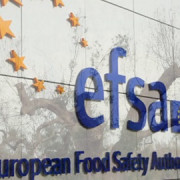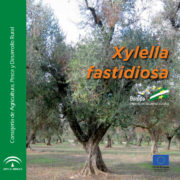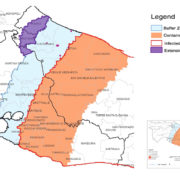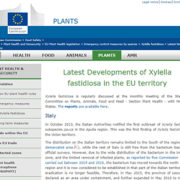Anticipating and understanding new Xylella fastidiosa epidemics across European landscapes; insights from remote sensing and network analysis
Authors
P. S. A. Beck (1), C. Camino González (2), R. Calderón Madrid (2), A. Hornero Luque (2), R. Hernández-Clemente (3), T. Kattenborn (4), M. Montes Borrego (2), L. Susca (5), M. Morelli (6), V. González (2), P. North (3), C. J. Carstens (7), B. B. Landa (2), D. Boscia (6), M. Saponari (6), G. Strona (1), J. A. Navas-Cortes (2), P. J. Zarco-Tejada (1)
Affiliations
(1) European Commission – Joint Research Centre, Ispra, ITALY; (2) Instituto de Agricultura Sostenible, Consejo Superior de Investigaciones Científicas, Cordoba, SPAIN; (3) Swansea University, Swansea, UNITED KINGDOM; (4) Karlsruher Institut für Technologie (KIT), Karlsruhe, GERMANY; (5) Università di Bari Aldo Moro, Bari, ITALY; (6) CNR – Institute for Sustainable Plant Protection, Bari, ITALY; (7) School of Mathematical and Geospatial Sciences, RMIT University, Melbourne, AUSTRALIA
Abstract Oral Presentation
Europe’s major X. fastidiosa outbreaks have progressed steadily in the past years as data on the bacterial strains causing them, and on the host range and vectors of the pathogen in various regions, became available. The initial uncertainty around these critical epidemiological aspects of the X. fastidiosa invasions hampered estimates of their rate and reach should eradication or containment efforts fail. We explored whether network analysis could help circumvent known knowledge gaps in X. fastidiosa epidemiology; Relying only on distribution maps of a known host plant (>60 000 olive groves), and the dispersal abilities of a putative vector, we gained network-based insights into the effort required for eradication or containment of the pathogen in southern Italy, and into opportunities to optimize pest management efforts at the landscapes scale. Early detection of new foci play a critical role in ensuring such efforts are efficient. Hyperspectral and thermal remote sensing, at spatial resolutions fine enough to delineate tree crowns, provide estimates of several plant functional traits in individual trees. After coordinated aircraft and field campaigns, we found that based on these traits, olive trees with X. fastidiosa infection symptoms can be detected and mapped with >80% accuracy. Furthermore, we found strong evidence that they, in some cases, allow the identification of X. fastidiosa affected trees weeks to months before they developed visible symptoms.
The present work has received funding from the European Union’s Horizon 2020 research and innovation programme under Grant Agreements No. 635646 – POnTE “Pest Organisms Threatening Europe” and No. 727987 – XF-ACTORS “Xylella fastidiosa Active Containment Through a multidisciplinary-Oriented Research Strategy”.
Published on October, 2018 by PHYTOPATHOLOGY









